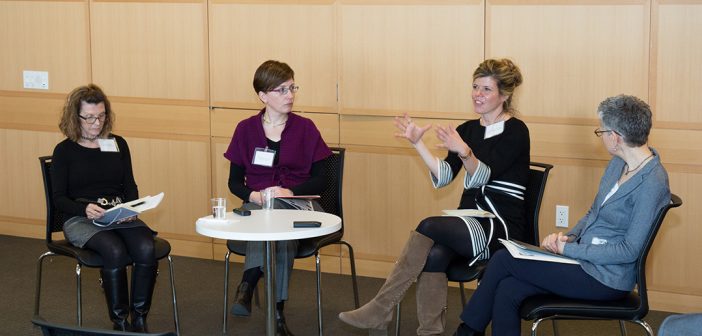Cities have limited influence over immigration policies, but they’re not completely powerless, and the increased federal crackdown on illegal immigration in the United States may actually be driving cities to band together to share techniques and strategies.
That was one of the conclusions of “Global Migration and Cities: Urban Governance, Migration, and the Refugee Crisis,” a panel discussion held Friday, Feb. 9 at the Lincoln Center campus.
The panel, which was part of conference organized by the Fordham Urban Consortium, featured
-Els de Graauw, P.D., associate professor of political science, at Baruch College
-Jennifer Gordon, professor of law at Fordham Law School
-Annika Hinze, Ph.D., assistant professor of political science and director of the Urban Studies program at Fordham
Judy Benjamin, Ph.D, the Helen Hamlyn Senior Fellow at the Institute of International Humanitarian Affairs, moderated the panel, which touched upon everything from the plight of Syrian war refugees to the estimated 500,000 undocumented immigrants living in New York City.
Hinze noted that although refugees are no longer confined to camps, and immigrants in the United States no longer only settle in “gateway” cities such as New York City, cities still offer a level of integration that a nation states can’t offer.
“There are already communities in place that provide immigrants with an intermediary, rather than being plunged into a new national context with different customs,” she said.
She said it’s also important to remember that immigrants are also settling in places like Alabama and North Carolina.
“This is an important conversation to have, because in a way, it takes away this dichotomy between the large metropolis and rural areas, because rural areas are increasingly feeding immigration,” she said.
De Graauw agreed, noting that immigrant affairs offices are springing up around the country.
“Ten to 15 years ago, you could probably count on one or maybe two hands how many cities had those offices. Today, we have over 40 of them, and they’re not just in the expected places like New York City. They’re also found in much smaller places, like Memphis,” she said.
“Cities are trying to figure out what they can do, because they are responsible for creating productive, healthy and stable communities. They know all too well that if you alienate or drive underground big segments of your population, it’s going to have ripple effects in many different ways.”
Local context is still important, as a place like Detroit is more amenable to the notion that immigrants are a demographic lifeline than say Atlanta, which de Graauw said is seeing greater immigrant population growth in the suburbs. But issues such as municipal I.D. cards, which New Haven first unveiled in 2007, bring together cities into groups such as Cities for Action, which a coalition of over 150 mayors and municipal leaders.
Gordon said Amman, Jordan, is a good example of how a city can ally itself with an international non-governmental organization to push its national government in a progressive direction. The European Union and the United Nations promised aid to Jordan if it agreed to make it possible for 200,000 Syrian refugees to work legally. In August, the national government agreed, but it restricted that employment to specific work, such as that in garment factories, and it set aside 20 desirable occupations to Jordanians. Amman officials have pushed back hard though, and have tentatively received exceptions for jobs in construction.
“That to me is a potential positive story about cities, and international human rights organizations combining to successfully put pressure on the national government,” Gordon said.



